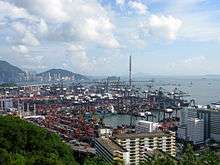Kwai Tsing Container Terminals

Kwai Tsing Container Terminals is the main port facilities in the reclamation along Rambler Channel between Kwai Chung and Tsing Yi Island, Hong Kong. It evolves from 4 berths of Kwai Chung Container Port (Chinese: 葵涌貨櫃碼頭) completed in the 1970s. It later expanded with two berths in the 1980s. Two additional terminals are added adjoining to Stonecutters Island in the 1990s and was renamed Kwai Chung Container Terminals. In the 2000s, when Container Terminal 9 on the Tsing Yi Island and was renamed to Kwai Tsing Container Terminals.
It has been the sixth-busiest container port in the world since 2016, just after Shanghai, Singapore, Shenzhen, Ningbo-Zhoushan and Qingdao.
History
The Container Committee was appointed by the Governor Sir David Trench on 12 July 1966 to advise the government on the containerisation revolution in cargo handling. In early 1967 the committee declared that Hong Kong had to build the capacity to handle containers, lest the territory's economy would suffer and its port would get bypassed in favour of Singapore and Japan.[1] The committee recommended the site at Kwai Chung. Two former islands on the Rambler Channel, Mong Chau and Pillar Island, were levelled and buried under the port.
While the port was under construction, a main road Kwai Chung Road was built to connect Kwai Chung and Kowloon. Container Port Road, a branch road of Kwai Chung Road, links the port with major industrial areas in Hong Kong.
The first container vessel to call on the new terminal, on 5 September 1972, was the Tokyo Bay.[2]
Thanks to the success of the Kwai Chung Port, Hong Kong overtook New York City in 1986 as the world's second-busiest port.[3][4] In 1987 it seized the title of world's busiest port from Rotterdam.[5]
Terminals
The port consists of nine container terminals and their operators:
| Terminal name | Abbreviation | Operator | Water depth (metres) |
No. berths | Quay length (metres) |
No. cranes | Area (square metres) |
Capacity (kTEUs) |
Year commissioned |
|---|---|---|---|---|---|---|---|---|---|
Kwai Chung terminals | |||||||||
| Container Terminal 1 | CT1 | Modern Terminals Limited | 14 | 1 | 4 | 1972 | |||
| Container Terminal 2 | CT2 | Modern Terminals Limited | 14 | 1 | 4 | 1972 | |||
| Container Terminal 3 | CT3 | Dubai Ports International (Hong Kong) Limited | 14 | 1 | 305 | 4 | 167,000 | >1,200 | 1972 |
| Container Terminal 4 | CT4 | Hong Kong International Terminals Limited | 12.5 | 3 | 8 | 1976 | |||
| Container Terminal 5 | CT5 | Modern Terminals Limited | 14 | 1 | 6 | 1988 | |||
| Container Terminal 6 | CT6 | Hong Kong International Terminals Limited | 12.5-15.5 | 3 | 11 | 1989 | |||
| Container Terminal 7 | CT7 | Hong Kong International Terminals Limited | 15.5 | 4 | 15 | 1990 | |||
| Container Terminal 8 (East) | CT8E | COSCO-HIT Terminals Limited [6] | 15.5 | 2 | 640 | 9 | 300,000 | 1,800 | 1993 |
| Container Terminal 8 (West) | CT8W | Asia Container Terminals Limited | 15.5 | 2 | 740 | 8 | 285,000 | >2,000 | 1993 |
Tsing Yi terminals | |||||||||
| Container Terminal 9 (North) | CT9N | Hong Kong International Terminals Limited | 15.5 | 2 | 700 | 9 | 190,000 | >2,600 (N&S) | 2003 |
| Container Terminal 9 (South) | CT9S | Modern Terminals Limited | 15.5 | 4 | 1,240 | 16 | 490,000 | 2003 | |
See also
| Wikimedia Commons has media related to Kwai Tsing Container Terminals. |
Notes
- ↑ "Moving cargo in containers: Need for H.K. to keep up with world developments". South China Morning Post. 27 January 1967. p. 1.
- ↑ "Shipping history today in HK's new container port". South China Morning Post. 5 September 1972. p. 29.
- ↑ "A port choked with business". South China Morning Post. 11 June 1987. p. 44.
- ↑ "Hongkong settles in with shipping's big league". South China Morning Post. 7 January 1987. p. 26.
- ↑ Marron, Gerry (13 December 1987). "HK overtakes Rotterdam as the world's busiest port". South China Morning Post. p. 62.
- ↑ Joint venture of Hong Kong International Terminals Limited and COSCO Pacific
Coordinates: 22°20′29″N 114°7′29″E / 22.34139°N 114.12472°E